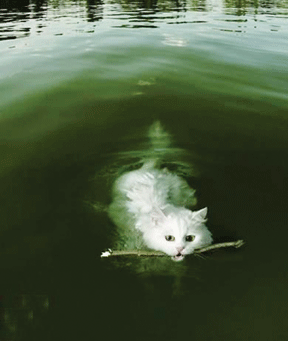
Volume XVII, Issue 34 # August 20 - August 26, 2009 |
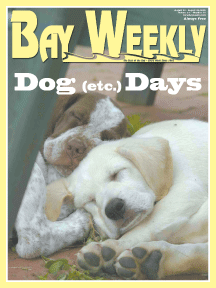 |
Pet Tales
Life lessons from our furred — and feathered — friends
Dogs seek out tile floors or position themselves in front of fans. Cats leave shady groves only for such ventilated perches as lattice lawn furniture. Birds dabble in baths. There’s a lesson here for how to survive the dog days of August.
But we humans (pant … pant) are too darn dumb to catch on.
It’s not like learning from the animals is anything new. From the snake in Genesis to the crow in Aesop, animals have spent ages teaching humans lessons about life. We grow up on animal stories, from The Very Busy Spider to The Call of the Wild.
For Dog Day this year, we’re heeding the lessons of the animals.
A Dog By Any Other Name Will Bite as Hard
by Diana Beechener
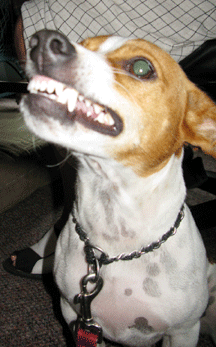 Dog experts have made a mint telling bewildered owners that there are No Bad Dogs. We put down our money, read the books and practice doggie discipline to create good canine citizens — in theory. While Bay Weekly’s Editor-at-Very-Large Moe has never needed much in the way of a canine comeuppance, our younger news hound Nipper Knoll (or as I’ve come to think of him, Editor-and-Teeth) is another story.
Dog experts have made a mint telling bewildered owners that there are No Bad Dogs. We put down our money, read the books and practice doggie discipline to create good canine citizens — in theory. While Bay Weekly’s Editor-at-Very-Large Moe has never needed much in the way of a canine comeuppance, our younger news hound Nipper Knoll (or as I’ve come to think of him, Editor-and-Teeth) is another story.
Nipper isn’t always ferocious. Editor-in-Chief Sandra Martin found the Jack Russell’s sweet side with no problem. With her, he snuggles, licks and wriggles. With me, he snaps, snarls and bites. As the proud owner of many dogs, I decided that I would tame the savage beast using my experience. As the proud owner of quick reflexes, I thanked God that my hand moved faster than Nipper’s mouth. Perhaps I would avoid the editor’s office.
I’m not alone. Cerberus couldn’t guard the editor’s office from unwanted Bay Weekly riffraff with more ferocity than this 20-pound terrier terror.
At last, his beleaguered owners pinpointed the cause of his beastly nature. The name. Why hadn’t anyone thought of it before?
Nipper wasn’t a bad seed. He was a good seed with a bad name. So Bay Weekly retired Nipper and welcomed Skipper to the office.
With excitement, I bounded up the stairs to greet my editor and the newly named dog.
“Hello Skipper!”
Grrrrr. Snarl. Snap, Snap.
Retracting my toes from bite range, I retreated to my desk.
Maybe we should have named him Sweetums.
Follow Your Dog’s Advice
by M.L. Faunce

![]() Once, I gave a copy of Life’s Little Instruction Book by H. Jackson Brown, Jr. to my nephew, Beau, thinking the thoughtful collection of observations and wise counsel might be a useful road map for this young man away from family and on his own life journey. You know, things like Look people in the eye, Say thank you a lot, Admit your mistakes, Whistle, Resist buying a boat, Be loyal, Buy a dog.
Once, I gave a copy of Life’s Little Instruction Book by H. Jackson Brown, Jr. to my nephew, Beau, thinking the thoughtful collection of observations and wise counsel might be a useful road map for this young man away from family and on his own life journey. You know, things like Look people in the eye, Say thank you a lot, Admit your mistakes, Whistle, Resist buying a boat, Be loyal, Buy a dog.
It’s the Buy a dog part that perked up the ears of my dachshund, Rose. As I read the full 511 gentle life instruction points, which also included count your blessings and never give anyone a fruitcake, I sensed Rose’s under-the-breath sigh, Duh!
Thus commenced a collaboration by dog and dog’s person. As my precious pup never mastered the pen-in-paw part of writing, I transcribed her powerful prose, which inspires me daily:
• Take naps
• Be early for breakfast
• Don’t walk when you can run
• Stay and sit (learn human speak)
• Be early for dinner
• Don’t let an itch go unscratched
• Clean your plate
• Look people in the eye (they can’t resist this)
• Treat your human as you would like to be treated
• Don’t carry a grudge (you might lose treats)
• Howl at the moon
• Find an available lap
• Keep your nose to the ground (you never know what you’ll find)
• Don’t cross a cat (double duh!)
Not All Dogs Go to Heaven
by Rob Goszkowski
On Easter Sunday, my mother and sister Hannah were working in the yard after mass at St. Mary’s Church.
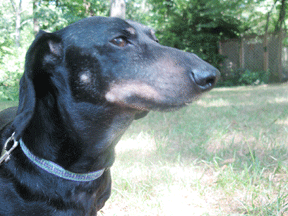
![]() Mother was weeding while Hannah gathered up piles of weeds and sticks. Spanky, Hannah’s 13-year-old miniature dachshund, was snuffling around in the ivy underneath some azaleas. This is what he usually does, sniff around, so he was paid no mind until my mother heard a squeak.
Mother was weeding while Hannah gathered up piles of weeds and sticks. Spanky, Hannah’s 13-year-old miniature dachshund, was snuffling around in the ivy underneath some azaleas. This is what he usually does, sniff around, so he was paid no mind until my mother heard a squeak.
“SPANKY!”
She ran over and pulled him out from under the bushes.
“Why did you yell at him, what happened?” asked Hannah, arriving next.
“He ate two bunnies.”
“How do you know he ate two?”
“They squeaked,” said my mother a little ruefully. “He must have eaten them after the squeak. There were two squeaks.”
There was a considerable amount of fur under the bushes making up the rabbits’ nest. In the middle, one tiny bunny remained.
“It happened so quick he must have just swallowed them whole,” my sister told me. “They were hamster-sized. Really cute.”
The moral depends on how you look at animals. From one perspective, Spanky, our pet and indeed family member, committed a ghastly offence against a symbol of the Easter holiday. From another, a simple fact of nature took place: One animal, a predator, ate a couple others, the prey.
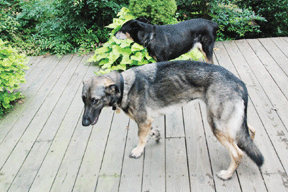
A Mutt Can Have Good Breeding
by Sandy Anderson
Graciousness may be what we’ve learned from our new dog
But this galloping gallute can’t possibly model grace. We chose Cheyenne from the Calvert Animal Welfare League to be a companion for our old dog, Cassie, which worked because of something like grace.
Cheyenne’s gentility may come from the borzoi (Russian wolfhound) we see in her, along with the stretch body built for racing, the tail touching the ground and the super-long nose with the little down-tilt. Or perhaps the German shepherd, which provided her coloring and sloping hips, but not an ounce of guard-dog potential. And it may be the black Lab, which contributed her webbed feet, black jowls and compulsion to carry a stuffed animal everywhere — though she won’t put a toe in the Bay.
She bumps you to rush ahead, then trips you by turning suddenly to see if you’re coming. To go out, she bowls Cassie and us to the side, grabs her toy, dives headlong down the stairs, then races in beautiful greyhound form (the borzoi) after squirrels. Still, she doesn’t challenge Cassie as top dog, shares her food and turns aside with a slight touch.
Grace must mean that her heart is in the right place.
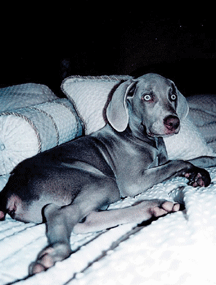
 Guilt Can’t Keep a Good Dog Down
Guilt Can’t Keep a Good Dog Down
by Steve Carr
We always had Weimaraners when I was growing up. That is a dog that can eat you out of house and home — literally. We called our last one Baggins, and he would demolish a room if you left him alone. We had to put everything out of reach before we left.
One day we forgot to Baggins-proof the kitchen. He destroyed everything he could pull down and get his teeth on: cookbooks were ripped into pieces, pens and ink smeared all over the floor, dishes pulled down and smashed, phone cord eaten, dish towels in tatters and newspapers shredded. Baggins could wreck a room with bomb-like precision.
He would greet us happily at the door upon our return, then slink away and cower under the dining room table because he knew he was in trouble.
After he got his butt kicked, he would go upstairs and jump in bed for a little nap after all his hard work. He would stretch out and sleep for hours, twitching and making these little whimpering sounds that melted your heart.
When Baggins passed away at the age of 12, it was the hardest loss I have endured — in truth, harder than the loss of my father. I have never owned another dog since.
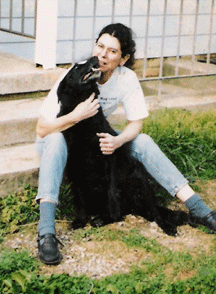
 Mother Is Top Dog
Mother Is Top Dog
by Al McKegg
My wife Janet communicated well with animals and was a particularly gifted and well-read dog trainer. She trained all our dogs to stay on our property without shock collars, simply employing the same techniques a mother dog uses on her pups.
The most memorable of these, as Janet practiced it, was to interrupt the undesired behavior by seizing the pup by the throat and jamming it onto the ground, yelling NO in a nasty tone. She’d hold it there until it stopped struggling and averted its eyes from hers, thus signaling (apparently) that it understood that behavior is forbidden and that she is the boss.
This technique established her reputation in our neighborhood as someone you shouldn’t mess with, be you human or dog. I didn’t realize just how well her reputation had spread until the day a Doberman sauntered up our driveway.
Like other guard dogs, Dobermans have been bred for centuries to be strong, fearless and capable of aggression, though not necessarily aggressive. Janet eyed this one as it trotted toward the house, threw the screen door open and ran toward it, yelling Get outa here! Go!
The petrified dog rolled onto its back and curled its tail between its legs. Janet stood over it until it averted its eyes.
She walked back in the house. The Doberman stayed on its back for perhaps a count of 10, then took off running in the direction it had come.

Love a Dog; Love the Mud
by Allen Delaney
After I acquired a very friendly, extremely lively black Lab from the pound last September, I figured I should take her to the marina so she could get used to being on my boat. As I held her leash, she eagerly pulled me down the pier. Once aboard the boat, my dog realized that she was no longer on solid ground. When I brought the boat around to the gas pump to top off the tank, the dog, seeking terra firma, jumped from the boat onto the pier and bolted toward the marina.
I ran after her, asking fellow boat owners which way she headed. Then I heard splashing. My dog had jumped into the scummiest, muck-filled culvert within our time zone. I went one way; she went the other. Finally, much to her horror, I jumped on top of her.
After winning the wrestling match, I picked her up and slogged down the boat ramp. A film of black water surrounded us. I’d like to say that a roll in the mud is enjoyable — but I’d be lying.
If You Love to Run, Run
by Ben Miller
One thing I learned from my father’s hunting dogs — English pointers and English setters — is that the dogs loved to work.
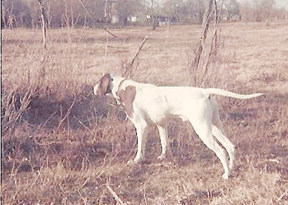
![]() They loved to run. They loved to hunt. They loved to point quail.
They loved to run. They loved to hunt. They loved to point quail.
When young, they also delighted in busting in on a covey hidden in the grass. It took training to get them to stand until the hunter flushed the birds.
But they learned, and they would hunt for hours on warm fall afternoons, ears and tails bloody from briars, pads cut and tongues hanging out.
At day’s end, unless put on a leash, they’d hunt until we reached the car, still coursing ahead following fence rows and the edges of woods.
There were many dogs over the years. Sally, Nip and Mike were pointers; Boy, Cassie, Mo and Katie were setters.
Boy lost a tail to a car but still won prizes in field trials.
These bird dog trials were my father’s passion. He enjoyed hunting quail on farms in West Virginia, but the competition and camaraderie of the field trials was what he really loved. His dogs, of course, loved them too.
The lesson: If you love to run, run.
 The Best Things in Life Are Free
The Best Things in Life Are Free
by Margaret Tearman
A life shared with animals — mainly cats and dogs, although over the years guinea pigs, hamsters and a blue-bellied lizard have also made their home with my family — has taught me what I believe to be the most important lesson: The best things in life are free.
My top ten list:
10. Snow in any form: flakes, drifts and balls;
9. Sticks, any size but long are best, and best are thrown;
8. Muddy puddles followed by a roll in the dust;
7. Warm sun;
6. Naps, anywhere, anytime;
5. Lawn sprinklers on a hot day;
4. Wildlife, roaming unconfined by fences or cages;
3. An itch scratched, under the chin, behind the ears or, most preferred, across the belly;
2. Trust;
And the most important lesson I’ve learned?
1. There is nothing more gratifying than to give and receive unconditional love.
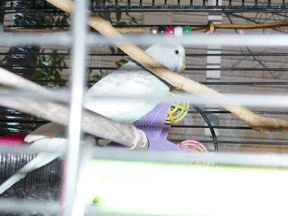
 English Is for the Birds
English Is for the Birds
by Jane Elkin
My parakeet refused to learn English. I coached him daily, coaxing him with treats as I talked to him. I bought him a motion-activated talking mirror that greeted him with a cheery hello every time he perched. I bribed visitors with a $50 reward if they could get him to speak even one word. All to no avail.
With summer, I moved his cage to the porch. He came alive to the sounds of nature, surrounded by his kin 24/7. By July he was screeching like a blue jay. By August he spoke fluent crow. And come September he was imitating the cry of a distant gull.
How could I have been so stupid? He didn’t want to communicate with me.
As a language teacher, I should have realized that hours spent listening to tapes of a language you will never use are wasted time. Total immersion and the need to communicate are what it’s all about.
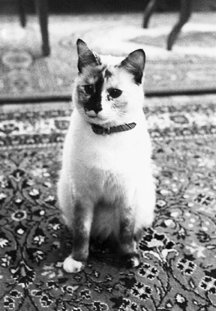 You May Need to Twist in Life to Land on Your Feet
You May Need to Twist in Life to Land on Your Feet
by Helena Mann-Melnitchenko
Did someone drop her off on our doorstep or did she find the way herself? We had returned from a few days celebrating Thanksgiving with our relatives, and there she was: a teenage kitty, mostly cream with brown markings. Unmistakably, half of her genes were Siamese, the other half tortoise shell.
It gave us pause. Our Siamese Tomcat, Pasha, had briefly spread his genes around the neighborhood. He died an untimely death from a poisoner’s hand. Could this beauty on our doorstep be his offspring?
After the trouble with Pasha, I didn’t want another cat. The older daughter knelt down: She looked half starved. We needed to feed her. The younger one ran into the house to get a bowl of milk. The girls pleaded with me every day. I resisted, but by the end of the week, the kitty’s and the girls’ persistence won. We took her in.
Kasha ruled our house for 18 years, escaping an early brush with death. We lived in a three-story house and in the spring, I liked to open the windows to let the sunshine in. The girls and I watched in horror from the second floor as Kasha plummeted to earth from the upper story. Then, something amazing happened. She twisted her body in mid-flight and hit the patio below, landing on her feet.
We, too, have learned to twist in life and land on our feet.
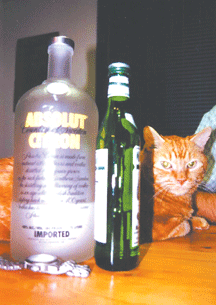
 All Species Are Equal before Pork
All Species Are Equal before Pork
by Betsy Kehne
There are few greater humiliations than a mugging by a cat.
The perpetrator: my 17-pound orange tabby named Prudence.
The target: a tender, juicy pork chop.
As I sat on my couch eating dinner, Prudence jumped up next to me, apparently in need of a cuddle. I was in mid-bite, fork lifting a bite of pork chop toward my open mouth, when I raised my free hand to scratch his ear.
That was when Prudence pounced.
With a swat of his paw, both fork and pork catapulted across the room. Prudence and I dove for it simultaneously. In the scuffle, I knocked my knees on the coffee table as Prudence streaked across the floor, paw pads squeaking on the hardwood like a basketball player’s sneakers. With a thud, he slid into the wall.
Have no doubt: That feline was fast, but my arms are long. I was driven by the desire to maintain one, tiny shred of dignity. I refused to give up that piece of meat to a cat who snarfed down four square meals a day.
Like a trophy, I gripped the fork above my head, its skewered pork prickled with cat hair. I may not have been able to eat it, but he didn’t eat it, either.
 Keep Your Priorities Straight
Keep Your Priorities Straight
by Dotty Holcomb Doherty
I always had a cat growing up. Throughout my grade school days and into high school, I kept Petey Boy, a large tom, at my side. We shared ice cream cones and a love for the outdoors.
When I took my first real job after college at a Maryland Quaker boarding school, it was only natural to add a kitten to my apartment on campus. Chebek, named for the call of the least flycatcher, was my buddy against loneliness. She greeted me when I came back from teaching or coaching, and slept tucked next to my stomach each night.
In the fall of my second year, my fiancé, Jonathan, came for a visit. I left him in the apartment for a nap, hoping his cat allergies wouldn’t flare up as I went to teach my afternoon classes. When I returned, Chebek was sleeping soundly on my pillow; Jonathan was struggling to breathe, curled in a ball at the foot of the bed. I knew in that instant where my priorities lay. That night, I gave Chebek away.

 Take Your Catnaps without the Cat
Take Your Catnaps without the Cat
by Sandra Olivetti Martin
I love an afternoon nap.
It may be best if the sun is shining — though a gray day has its own appeal. It is good to lie on top of sheets and blankets, for a catnap should be casual. But the temperature must be mild, preferably with a breeze coming through the open window so the fresh air is all the covering you need.
In the savory zone between waking and sleeping, I recognize that Tikal, a winsome orange tabby, is settling in at my neck for his own catnap. Another benefaction, and now sleep …
… postponed by the purring in my ear. By the long, elegant whiskers tickling my cheek. By the sandpaper tongue against my eyelid. By the claws kneading and tangling my hair.
All right, kitty. It’s the cat’s nap. You can have it.
Don’t Leave the Chicken Out
by Davina Grace Hill
That’s what I learned from my cat, Laptop.
 Laptop is a stray who huddled at the office doorway after a vicious nor’easter. She was tiny, bedraggled and couldn’t even give voice to her meows. She spent her first months as the office cat. Since she wanted to be in your lap only when you were on the computer, her name, naturally, became Laptop.
Laptop is a stray who huddled at the office doorway after a vicious nor’easter. She was tiny, bedraggled and couldn’t even give voice to her meows. She spent her first months as the office cat. Since she wanted to be in your lap only when you were on the computer, her name, naturally, became Laptop.
My office assistant was eating a chicken sandwich at lunch when interrupted by a call. She talked for quite some time from an extension away from her desk.
When she returned to her desk, she was puzzled. There was her sandwich, neatly pulled apart, bread, lettuce and tomato remaining, but absent the sliced chicken that had been in the middle. It was such a neat job, but it made no sense. Until we found Laptop in the corner, licking her paws.
Laptop now lives at home, and more than a decade has passed. But it is still true: You cannot leave chicken unattended, no scraps left in a pan on the counter or a quick step away from the table to get a napkin, nothing. If you do, the chicken belongs to Laptop.
